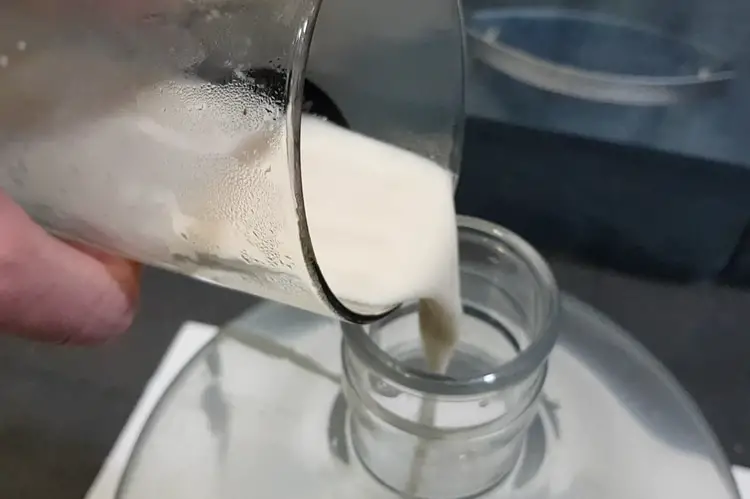As the Over/ Under designation implies, it misses a target. There is an optimum pitch rate and non-optimum. Some yeasts can adapt with few metabolic issues. Others respond less well and have serious consequences, creating bad or flawed beer.
Over or under pitching yeast is extremely problematic. Yeast is a living organism and needs basic requirements to live, namely O2, nutrients, and food. If out of balance, a host of off-flavors and side effects ensue. This practice will ruin a good beer.
The Vital Nature of Yeast
For those of you who’ve followed my writing these last months, you know I am a yeast-centric brewer.
I believe yeast to be the critical component of beer around which all others revolve.
Today there are over 100 strains of pure liquid strains and another several dozen varieties of dried yeast.
When I began brewing in the 90’s, only a fraction of these choices existed.

What Does Overpitching and Underpitching Mean?
Adding too many or two few viable yeast cells ruins a proper wort.
Overpitching exhibits truncated respiration, a flash fermentation (12-24 hours), and stressed yeast.
Underpitching leaves the yeast unable to reach critical mass of cell count. It sticks in respiration.
When Do You Really Underpitch?
You underpitch when the yeast can’t multiply and hasn’t enough cells to begin proper fermentation.
What Are Underpitching Effects?
Underpitch and the yeast struggles to grow, lacking the energy and cell count to establish a stable fermentation. Chemical by-products pervade, souring, burning, and bittering the wort beyond recognition.
Underpitching is not OK. Ale yeast will fail to reach its cell count equilibrium and fermentation will fail to properly begin.
Some of the same off-flavors detailed in the Overpitch section (below) will occur.
Here are two by-products in brief:
- Mercaptan (ethanethiol): kitchen sink drain, sulphury, rotting garbage
=> Cause – broken yeast cells, anaerobic bacterial infection - Hydrogen Sulphide (H2S): Rotten eggs, sulfur, sewage.
=> Cause – autolysis and stressed yeast.
Several factors could lead to yeast underperforming or not properly metabolizing at all.
Reasons underpitched yeast hasn’t the vitality to reproduce in great enough numbers to work include:
- Low levels of dissolved O2.
- Low nutrient level or protein chains that provide necessary nutrients for yeast to respire.
- Yeast is expired, overused or too cold.
Cases When It’s OK to Underpitch
It is really never OK, except in one instance I can think of.
Should you be making an Abbey-style beer for example, it may be easily aged for 8 – 12 weeks.
In this case, it could be soured before racked into secondary or tertiary fermentation.
Definitely use glass or steel at this stage.
When racking into the secondary, you could pitch a small vial or starter into the beer.
It is anaerobic at this stage, but wild yeasts are in reality contaminants and will work, even thrive in non-O2 environs.
When flavoring beer and creating a profile for long-term storage and development, here are some off-flavors that occur, several of them are normal and even desirable for aged, sour, or extremely strong beers.
- Phenolic – Bitter, spicy, herbal, tea-leafy, clove-like, medicinal.
- Wild specialty yeasts, contamination, high fermentation temps
- Styles: Barley Wine, White beer, Abbey Beer
- Cheesy (Isovaleric Acid): Gouda cheese, rancidity, goaty, dirty socks, horse blanket, barnyard
- Oxidized hops (common in Belgium),
- Wild yeast contamination, intentional or not
- Styles: Lambic, Old Brown, “Wild” American Ales
- Caprylic (octanoic or caprylic acid): Goatish, tallow-like, vegetable oil, waxy, goat cheese
- Fatty acids produced by yeast in low pH conditions (sour, infected beer)
- Styles: Again, the sour beers
- Sweet: Cloying, syrupy, candy-like
- Poor yeast nutrients, low dissolved O2 content, old yeast
- Stuck fermentation
- High terminal gravity
- Styles: Tripels, quadruple bocks, strong ales of any variety, north of 10%
All of the above characteristics can ruin a standard beer.
I don’t recommend aiming for these profiles, though as noted, they do exist and even define some styles.
When Do You Really Overpitch?
You over pitch when you double or triple the necessary yeast count. Overpopulated, they quickly consume all available O2 and fermentable sugar. The yeast is so over-concentrated, proper fermentation is irreversibly altered.
What Are Overpitching Effects?
Overpitch and the yeast cannibalizes itself, autolyzes (the cells rupture), and off-flavors form. Luncheon meat, scouring acidity, goat-hide are all potential off-flavors when overpitching Ale yeast. It can also negatively impact attenuation and ester formation.
Ale yeast performs best at 62˚ – 68˚ F (16° – 20° C).
It works from the top, working itself into an intense froth called the krausen /croyzǝn/. This dense rocky head is where the viable yeast works and with ale yeast, no cell will be left out.
As a homebrewer, it is difficult to overpitch but it may happen.
The most likely time is when an enterprising intermediate brewer or aspiring journeyman wants to reuse or repitch yeast a second time.
This is an acceptable practice, just know the risks. When ale yeast over propagates problems occur quickly. It quickly consumes all the oxygen in the wort in a matter of minutes or short hours.
It then goes to work on the maltose. In theory, this sounds great, fast-working and guaranteed cell count.
Not so fast.
It quickly runs out of food and due to its premature saturation point, it starts eating itself.
Yes, it turns cannibalistic.
This dreaded inconvenience is called autolysis – overpitching not the only cause – wherein the cell walls break apart, disintegrating into the beer itself.
It not only loses its ability to reabsorb volatile compounds natural to fermentation but become a liability itself.
Autolyzed yeast cells will make the beer permanently cloudy at best and add debilitating off-flavors at worst.
The following are the Greatest Hits, but not limited to:
- Mercaptan (ethanethiol): kitchen sink drain, sulphury, rotting garbage
- Broken yeast cells, anaerobic bacterial infection (occurs in underptiching also)
- Hydrogen Sulphide (H2S): Rotten eggs, sulfur, sewage.
- Autolysis and stressed yeast can also occur in underptiching.
- Queue Frank Zappa’s Devil in the Classic “T#tties and Beer” Yes, it was him alright, I sweared I knowed it was …
- Isoamyl Acetate: Fleshy fruits, estery, bananas, lacquer or acetone at higher levels
- Wheat styles can integrate if below a certain threshold
- Caused by stressed yeast and autolysis
Friends, this is just a sampling of what you can look forward to with an overpitched ale.
I have experienced all of them, at home and professionally, so don’t feel bad now or later, as it happens to everyone.
It falls squarely in the NOT recommended column.
Cases When It’s OK to Overpitch
There is one instance where overpitching is OK. Lager beer.
Lagers ferment at very low temperatures -relative to ales- about 42˚ – 53˚ F (5° – 11° C).
Due to their slow metabolic rate, they do not react in the same way as ale yeast. By their nature and definition, they rest on the bottom and work slowly. Should they be overpitched, they will simply sleep and not work so hard.
I brewed lagers extensively for 6 years at French Broad Brewing Company and underpitching never was a problem.
My equipment bought second-hand from NYC included largely dish-bottomed fermenters. It is hard to harvest yeast consistently in this case.
When transferring from the kettle on brew day, I would have an empty tank connected by means of a T- coupler. Lager yeast would still be resting in the bottom of the dish covered by a protective layer of finished beer.
While transferring I would redirect the flow from the waiting fermenter into the yeast tank. After 30 seconds I would open the yeast tank valve and the valve to the waiting batch fermenter and yeast would flow. I would do this from 3 – 6 times, depending on the feel.
It was a small 15 bbl. brewery. I knew it was hard to overpitch, and that was how I rolled. There were occasional problems, but underpitching lager yeast was not one of them.
Can You Fix Overpitch or Underpitch Yeast?
Initially, the answer is firmly no. Once the beer becomes prematurely anaerobic (overpitched), or stuck in respiration for more than 24 hours (underpitched), it cannot be changed.
If within 12 hours you feel you have underpitched you can introduce more yeast and the beer may have time to respire and commence proper fermentation.
One other thing to be done if you haven’t enough yeast is add O2 with a ceramic stone for a few hours during respiration, immediately after pitching.
This will give the yeast time to naturally multiply. It must happen upon pitching only, not after. This is recommended for intermediate or journeyman brewers only.
The Proper Pitch-count
The yeast market has grown tremendously over the last 15 years. There are at least a stunning 100 pitchable pure liquid cultures available from throughout the brewing world. Mind-Boggling.
Read much more about liquid yeast in, Dry Yeast vs Liquid Yeast: Which One to Use for Homebrewing?
When I first homebrewed in the 90’s we had 1 yeast company, perhaps 16 strains, and 6 – 10 varieties of dried yeast.
The packets from Imperial Organic Yeast Company advertise a 200 billion cell count right on the package. That is more than I thought it was.
To get technical, the “target pitching 1.5 million cells per degree plato (pitch 18 million cells/ ml for a 12 plato lager).” (Pearson, Bryant: Brewing Science Institute) Feel free to do the math.
The point is, there is no reason to underpitch and the price difference between pure liquid and premium dried yeast is only $3-4.00.
Most yeast packages are produced for 5 gallon pitches. If brewing less than this, measure the dried yeast by weight, or the liquid yeast by volume.
As for hydrating dried yeast, which I still recommend, I go into some detail in the article, Do You Really Need to Rehydrate Your Dry Yeast Before Pitching?
What Happens if You Pitch Yeast When Wort Is Too Hot?
Pitching hot risks flash fermentation. Entering frenzy mode, the yeast rapidly consumes all the oxygen. Fermentation begins before proper respiration. Then nothing but half fermented beer with unhealthy yeast remains. Therein lies the worst of both worlds; under and overpitching.
Propagating Final Thoughts
It is difficult for the homebrewer to count yeast cells and be sure exactly how much goes in. Use a pitchable pack of the myriad varieties and brew to style. It’s hard to go wrong.
Overpitching is a modest risk for homebrewers. Should you harvest for second pitching, you may want to make a yeast starter the old-fashioned way.

